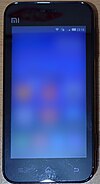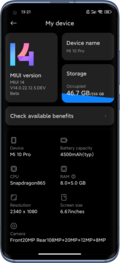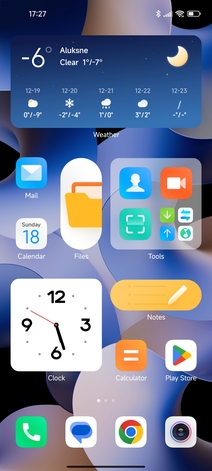MIUI[a] is a deprecated mobile operating system by Xiaomi for its smartphones and devices, from 2010 to 2023,[3][4][5] prior to the launch of its successor Xiaomi HyperOS.[6]
| Developer | Xiaomi |
|---|---|
| OS family | Android-like OS (Android-based Linux OS) |
| Source model | Open source (Modified Android Base and Main Framework) with Proprietary components (MIUI Apps and Kits)[1] |
| Initial release | 0.8.16 / 16 August 2010 |
| Latest release | Varies by mobile phone and region. |
| Latest preview | V14.0.23.10.8.DEV (Mainland China) / 17 August 2023 |
| Marketing target | Alternative OS replacement for Android devices; Stock firmware for Xiaomi smartphone and tablet |
| Available in | 77 languages (varies by country) |
| Package manager | APK-based |
| Platforms | ARMv7, ARM64, MIPS, x86, x64 |
| Kernel type | Monolithic (modified Linux kernel) |
| License | Proprietary |
| Succeeded by | Xiaomi HyperOS |
| Official website | www home |
MIUI was based on the Android Open Source Project, and served as the basis for other OS deviations by Xiaomi: MIUI for Poco, MIUI Pad, MIUI Watch, and MIUI TV (PatchWall).[7]
There are different versions for each Xiaomi phone model, and each version has regional variants dependent on where the phone is sold, including China, Europe, Indonesia, India, Japan, Pakistan, Russia, Taiwan and Turkey. Xiaomi have also released a few devices running Google's Android One instead of MIUI. Xiaomi devices usually get three Android version updates, but get MIUI updates for four years (less for budget models).[8]
The first MIUI ROM, released in 2010, was based on Android 2.2.x Froyo and was initially developed in China by Xiaomi in its first year of operation.[9] Xiaomi added a number of apps to the basic framework, including Notes, Backup, Music, and Gallery apps.[10]
An organisation named Xiaomi Europe, using the domain xiaomi.eu and working officially with Xiaomi despite not being affiliated with the Chinese company,[11] was set up in 2010 as a community for English-language Xiaomi users with phones running MIUI associated with an Android version. The website issues its own stable and weekly versions of Xiaomi MIUI ROMs based on the stable, and on the weekly beta versions of the Chinese ROM.[11] Installing the xiaomi.eu ROM, however, voids the warranty on Xiaomi phones; according to the xiaomi.eu leader, the official ROM must be flashed and the bootloader locked before returning a device for warranty repair.[12]
Xiaomi is replacing MIUI with its new Android-based operating system HyperOS, starting with the Xiaomi 13 series and Pad 6.[13]
Google Play services
Google has had disagreements with the Chinese government, and the Great Firewall currently blocks access to all Google services. Since Xiaomi has expanded its operations outside China, MIUI releases for Android devices outside mainland China have Google Play Services and Google Apps such as Gmail, GMaps, YouTube and Google Play pre-installed and functioning as on any other Android device. MIUI global versions are certified by Google, as are all MIUI devices, which ship with Google Play Services since MIUI 12.5.[14]
Comparison of all MIUI variants
| China | Global | Xiaomi.eu | ||||
|---|---|---|---|---|---|---|
| Languages available | Few, including Chinese and English | Wide selection | ||||
| Selection of downloadable themes | All | Some | ||||
| Drag up search | Yes
with international Bing and selection of Chinese search engines |
Google App or Mi Browser | Yes | |||
| Smart Assistant | App vault | Google Discover (App Vault in Indonesia, India, Russia and Taiwan) | App vault and Google Discover | |||
| Default source of apps | GetApps | Google Play, Mi Picks/GetApps[15] | Google Play | |||
| Xiaomi Cloud services | All | Some | All | |||
| Updates | Developer | Stable | Beta | Stable | Dev/Beta | Stable |
| No longer available | Usually updated every two months[16] | No longer available | Usually updated every three months | Updated every Friday | Usually updated every two months | |
| OTA | Yes | Yes; patches are not supported, so a complete new ROM is downloaded each time | ||||
| Official | Yes (made by Xiaomi) |
Approved by the official distribution in the European Union.[11] | ||||
| Custom recovery requirement | No | Some (recovery ROMs only) | ||||
| Additional features |
|
Optional access to various Chinese online services | Google apps on some ROMs instead of MIUI apps (Dialer, Messages, Contacts, Calendar) |
| ||
| Supported Xiaomi devices | Majority
excluding devices never released in PRC Older devices may not be updated |
Majority
excluding devices never released outside PRC Older devices may not be updated | ||||
Android
Although MIUI is built on the Android platform, the default user interface of its earlier iterations resembled iOS due to the absence of the application tray,[17] with a grid of icons arrayed in the home panels. Other iOS similarities include the app icons being in a uniform shape, the dialer and in-call interface, the organization of the Settings app, and the visual appearance of toggles in the UI. This prompted some observers to cite how the devices running on MIUI could appeal to iOS users wanting to switch to the Android platform.[17] By 2018, MIUI was increasingly shifting towards a design aesthetic more similar to stock Android. For instance, several elements in builds of MIUI 10 resemble Android Pie features, such as the multitasking menu and gesture controls.[18] This change was first seen in MIUI 9 (ver. 8.5.11) that shipped with Xiaomi Mi MIX 2S.[19]
Another difference from Android is MIUI's support for themes and custom fonts. Users can download theme packs and fonts, which can change the user interface of the device when installed from the Mi Themes Store. It also allows more advanced users to tweak the hard-coded firmware of the handsets.[20]
Issues
As MIUI's kernel was proprietary, it was in breach of Linux kernel's GPL.[21][22] The source code of certain components was released to GitHub on 25 October 2013.[23] Kernel sources for a few devices, including the Mi3, Mi4, MiNote, and Redmi 1S, were released in March 2015.[24]
In order to raise funds for the company, MIUI has its own online services from Xiaomi, including cloud services, paid themes and games. Payments are transacted using the Mi Credit digital currency.[25]
After the government of India banned over 100 Chinese apps and services in 2020 due to national security and privacy concerns, including some made by Xiaomi, the company developed a separate MIUI version without them for India.[26][27]
Vulnerabilities
In April 2019, security researcher Arif Khan reported that Xiaomi's browser apps Mi Browser and Mint Browser suffered from a vulnerability that allowed the URL address bar to be spoofed, which affected Indian as well as certain global versions of MIUI. Xiaomi gave Khan a Bug bounty but opted not to fix this issue.[28][29] In addition, a vulnerability in a wallpaper carousel app Glance on Indian versions of MIUI allowed a user to bypass the lock screen and access clipboard data.[30][31] This vulnerability was eventually fixed by Xiaomi.[31]
Performance issues
Some users encountered issues such as touch response problems on MIUI 12.5.[32] Users also complain about overheating, slow performance, drop in framerate, unstable app function and files randomly missing from their phone's storage. The update to MIUI 13 brought several performance improvements.[33]
Version history
| Version | Screenshot | Android version | Date of release | Last Stable release | Initial Beta release | Last Beta release | Notable change |
|---|---|---|---|---|---|---|---|
| MIUI V1 | [34] |
2.1 | 16 August 2010 | 0.8.16 | Unknown |
| |
| MIUI V2 |  |
2.1-2.3.6 |
Unknown | — | Unknown | Unknown |
|
| MIUI V3 | 2.3.6 | Unknown | — | Unknown | 2.4.20 |
| |
| MIUI V4 | 4.0.4 – 4.1.2 | Unknown | ICS24.0[35] | Unknown | 3.2.22 |
| |
| MIUI V5 |  |
4.1.2 – 4.4.2 | 1 March 2013[36] | 31.0[37] | 3.3.1 | 4.12.5 |
|
| MIUI 6 | 4.4.2 – 5.0.2 | 29 August 2014[38] | 6.7.2.0 | 4.8.29 | 5.8.6 |
| |
| MIUI 7 |  |
4.4.2 – 6.0.1 | 13 August 2015[39] | 7.5.9.0 | 5.8.12 | 6.5.26 |
|
| MIUI 8 |  |
4.4.2 – 7.1.2 | 16 June 2016[40] | 8.5.10.0 | 6.6.16 | 7.7.20 |
|
| MIUI 9 |  |
4.4.2 – 8.1.0 | 10 August 2017 | 9.6.5.0 | 7.8.10 | 8.5.24 |
|
| MIUI 10 | 6.0 – 9 | 19 June 2018[41] | 10.4.5.0 | 8.6.14 | 9.9.6 |
| |
| MIUI 11 |  |
7.0 – 10 | 22 October 2019 | 11.0.14.0 | 9.9.24 | 20.3.26 |
|
| MIUI 12 |  |
9 – 11 | 27 April 2020 | 12.2.7.0 | 20.4.27 | 20.12.10 |
|
| MIUI 12.5 |  |
10 – 12 | 28 December 2020 | 12.5.26.0 | 20.12.25[44] | 21.7.5 |
|
| MIUI 13 |  |
11 – 13 | 28 December 2021 | 13.2.8.0 (Mainland China) 13.2.6.0 (Global Market) |
21.7.6[45] | 13.1.22.10.25.DEV (Android 13 Weekly) 13.1.22.10.24.DEV (Android 12 Weekly) 22.11.23 (Daily Beta for some devices) 22.10.26 (Daily Beta) |
|
| MIUI 14 |  |
12 – 14 | 11 December 2022 | 14.1.10.0 | 14.0.22.12.5.DEV | 14.0.23.10.8.DEV |
|
See also
Notes
References
External links
Wikiwand in your browser!
Seamless Wikipedia browsing. On steroids.
Every time you click a link to Wikipedia, Wiktionary or Wikiquote in your browser's search results, it will show the modern Wikiwand interface.
Wikiwand extension is a five stars, simple, with minimum permission required to keep your browsing private, safe and transparent.


